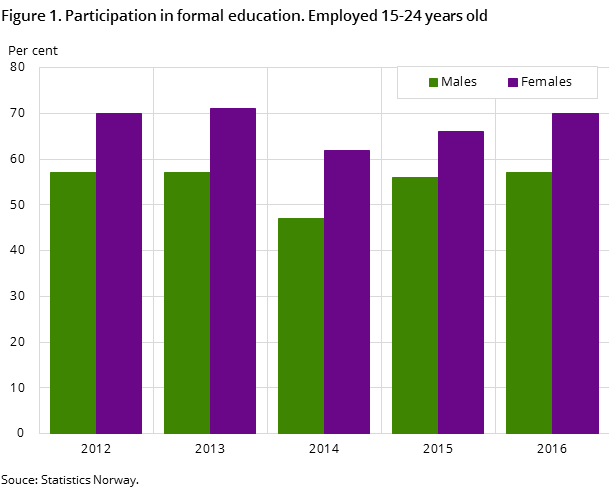Content
Published:
This is an archived release.
More young people in employment participate in formal education
Over half of the 15-24 age group has participated in formal education in the last 12 months. The highest participation was among those that were not in employment, but a high number of those in employment also participated in formal education.
| 2016 | 2015 | |||
|---|---|---|---|---|
| Participants in formal education (per cent) | Participants in non-formal education (per cent) | Participants in formal education (per cent) | Participants in non-formal education (per cent) | |
| Employed persons | 15 | 49 | 16 | 50 |
| Not employed | 39 | 18 | 39 | 17 |

Lifelong learning is important both for the individual's participation in social and working life, and for society as a whole. Lifelong learning is a priority at the national level, and internationally. The EU has a target of increased participation by 2020.
In the 1st quarter of 2016, more persons in the age group 15-24 participated in formal education than in the corresponding quarter last year. Participation in formal education in this age group is 63 per cent in 2016; an increase of 2 percentage points compared with the previous year. The largest increase was among younger women in employment with 70 per cent; an increase of 4 percentage points from 66 per cent in 2015. Participation in formal education among younger men in employment varied between 47 and 57 per cent from 2012 and 2016. Corresponding figures for younger women varied between 62 and 71 per cent. The lowest rates of participation for both men and women were in 2014 with 47 and 62 per cent respectively.
80 per cent of 15-24 year olds not in employment participated in formal education
Over 80 per cent of 15-24 years olds not in employment participated in formal education according to the 2016 figures. About 40 per cent of 25-34 year olds participated in formal education; a decline of 4 percentage points from 2015, while none within the age group 62-66 participated in formal education.
Professionals and managers participate more often in non-formal education
About 50 per cent of employed persons between 15-66 years have participated in non-formal education within the last 12 months. Persons employed in professional and managerial occupations participate most frequently in non-formal education. Over the last 12 months, 62 per cent of professionals and 61 per cent of managers have attended non-formal education. Approximately 64 per cent of women in professional occupations have attended non-formal education in the last 12 months. The participation rate is lowest among plant and machine operators and assemblers, where 32 per cent attended non-formal education in the past year.
Persons who were employed in the industries public administration, defence and social security and financial and insurance activities had the highest rate of participation in non-formal education. Figures for 2016 show that 61 per cent of employees in this group have attended non-formal education over the last 12 months, compared with 30 per cent of persons who worked with accommodation and food service activities.
People with higher education participate more in non-formal education
Educational background is significant in the rate of participation in non-formal education. For those with a higher education, 60 per cent of employees have participated in non-formal education over the last 12 months. The corresponding figures for persons with primary and lower secondary education were 45 per cent and 34 per cent respectively.
Additional information
The Learning Conditions Monitor (LCM) is an annual ad hoc module to Statistic Norway’s Labour Force Survey (LFS) in the first quarter. The ad hoc survey focuses mainly on participation in education.
